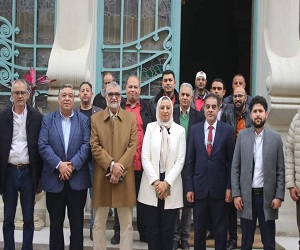An inspection visit to the restoration work of the Zaffran Palace at Ain Shams University
Within the framework of following up the restoration work of the Zaffran Palace, Ain Shams University, which is being implemented by the Arab Contractors Company, Dr. Ghada Farouk, Vice President of Ain Shams University, and Engineer Imam Afifi, Vice Chairman of the Board of Directors of the Arab Contractors Company, Dr. Yasser Mujahid, Director of the Engineering Consultation Center at the university, Dr. Mamdouh El Damati, former Minister of Antiquities and former Dean of the Faculty of Archeology, Dr. Gamal Mustafa, Deputy Secretary-General of the Supreme Council of Antiquities, and Dr. Nasr Eid, Advisor to the Vice President of the University, visited the work site in the palace.
The visit included standing on the progress of the ongoing works, which include the meticulous restoration of the archaeological spaces in the ground floor and the basement, the structural and meticulous restoration work of the museum display part in the basement, and the electromechanical works of the palace to serve the re-employment, as well as civil and finishing works, and agricultural works in the general site.
They were accompanied during the visit by the engineers, Taha Diab, Director of the Palaces and Antiquities Maintenance Department, Salam Rashad, Director of the Electromechanical Projects Department for Public Buildings and Utilities, Mohamed Khader, Director of the Electrical Works Department, Ahmed Othman, Deputy Director of the Palaces and Antiquities Maintenance Department, and Hassan Ibrahim, Project Manager.
 |
 |
It is mentioned that the Zaffran Palace dates back to the age of Khedive Ismail, and it was designed along the lines of the Palace of Versailles in France, in which the Khedive used to spend his education period, and it contains decorations between the Gothic style and the Baroque style, which are two of the most important architectural styles that were used in many palaces of the nineteenth century.
The palace consists of three main floors in addition to an underground floor, which includes the first floor dedicated to the reception, the main hall, and two side halls for the reception as well as the lunchroom, while the second floor includes eight bedrooms, each room attached to a salon for the reception, and the colored ceilings are among the most important features of the rooms of this floor.
As for the external facades of the palace, they are characterized by wonderful architectural and decorative elements represented in windows, knotted balconies, columns, and spherical shapes surmounted by royal crowns. The palace has five entrances, two main ones, on the northern and southern side, and two secondary ones, one in the southwestern corner and the second in the southeastern corner, in addition to an entrance in the western facade leading to the basement. The northern facade of the palace is the main facade, which is similar to its southern counterpart, and it consists of one block protruding from the facade in the middle of it is the entrance hole, which consists of two shutters made of iron covered with stained glass dotted with lead. This entrance leads to a transverse hall with another door opening leading to the inside of the palace. An inscription at the top of this door, as well as all the doors of the rooms, are the initials of Khedive Ismail’s name, as well as the shape of his crown.
.svg)




